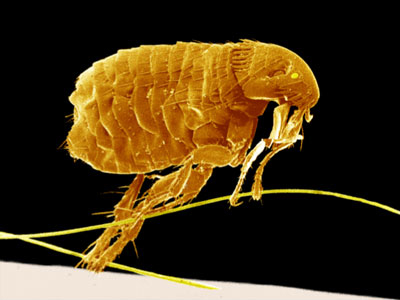Fleas
Fleas are the most common external parasite found on cats (and dogs). (Parasites are "freeloaders" that live in or on another creature.) Although fleas are more likely to be a problem during warm-weather months, they can  also cause problems during cooler seasons due to their ability to continue their life cycle indoors.
also cause problems during cooler seasons due to their ability to continue their life cycle indoors.
How will fleas affect my cat?
You will probably first notice the effects of fleas when your cat repeatedly nibbles at and licks its haircoat and skin. On occasion you may actually see tiny brown fleas moving quickly through your cat's haircoat. Cats are very skilled groomers, however, and may remove fleas so well that you do not see them. Your cat's constant nibbling and licking may lead to noticeable patches of hair loss, tiny crusts (called miliary dermatitis by your veterinarian), and reddened, irritated skin. Fleas may also cause skin allergies and can transmit other parasites, such as tapeworms, to your cat.How do I check my cat for fleas?
Adult fleas are usually more difficult to find on cats than on dogs. One of the best methods for checking your cat for fleas is to look for flea dirt (actually flea feces) in your cat's haircoat.
To check for flea dirt, briskly comb or rub a section of the hair on your cat's back while your cat is sitting or lying on a white piece of paper. If your cat has fleas, black flecks that look like dirt (as a result, we use the term "flea dirt") will fall onto the paper. If you transfer these black flecks to a damp piece of paper, in a short time they will appear red or rust-colored. The red color results because blood sucked from your cat is passed in the flea's waste matter. If the dirt specks do not turn red, then they are probably "regular" dirt.
How do I prevent my cat from getting fleas?
Indoors
To control fleas, you must stop them from reproducing. Carpets, pet bedding, furniture, wood floors, and other indoor areas where your cat spends much time will contain the highest number of developing fleas (see the video above). Frequent vacuuming of these areas (throw the vacuum cleaner bag away afterwards) and frequent washing of pet bedding can greatly reduce the number of developing fleas inside your home.
Outdoors
Fleas also develop in shady, protected outdoor areas, although the outdoor areas are usually of less concern to pet owners who only have cats and do not have dogs. Most flea problems can be managed by treating and preventing fleas right on your cat. Remember that dogs and cats can share fleas, so be sure that dogs in your house are treated, too. It is important to remember that flea problems may be different from pet to pet or between households, and each problem may require a special method of control.
Steps to Take
See your veterinarian for advice on your specific situation. Your veterinarian can recommend safe and effective products for controlling and killing fleas and can determine exactly what you need. Your veterinarian can also determine whether you should consult with a pest control specialist about treating your home and yard or recommending products that will break the flea life cycle in the environment.
For veterinary professionals, more detailed information on fleas can be found at https://www.capcvet.org/guidelines/fleas/.
Did you know?
- You may see fleas in your home or on your cat, or simply see your cat nibbling at and licking itself.
- If not treated, you cat may suffer patches of hair loss or reddened, irritated skin. Fleas can also carry other parasites.
- Frequent vacuuming and/or washing of pet bedding, carpets and furniture can help control fleas.
- Cats and dogs can share fleas.
- Flea treatments for your cat can protect it and break the flea life cycle.
Learn More about Specific Parasites
- Overview
- Coccidia
- Dandruff
- Ear Mites
- Fleas
- Heartworms
- Hookworms
- Mange
- Roundworms
- Tapeworms
- Ticks
- Toxoplasmosis
Ask Your Veterinarian
While fleas are primarily an annoyance, they can carry other illnesses. Dealing with fleas requires both controlling flea populations in your pet's environment and killing fleas on your pet. Your veterinarian has treatments that are not available over the counter.